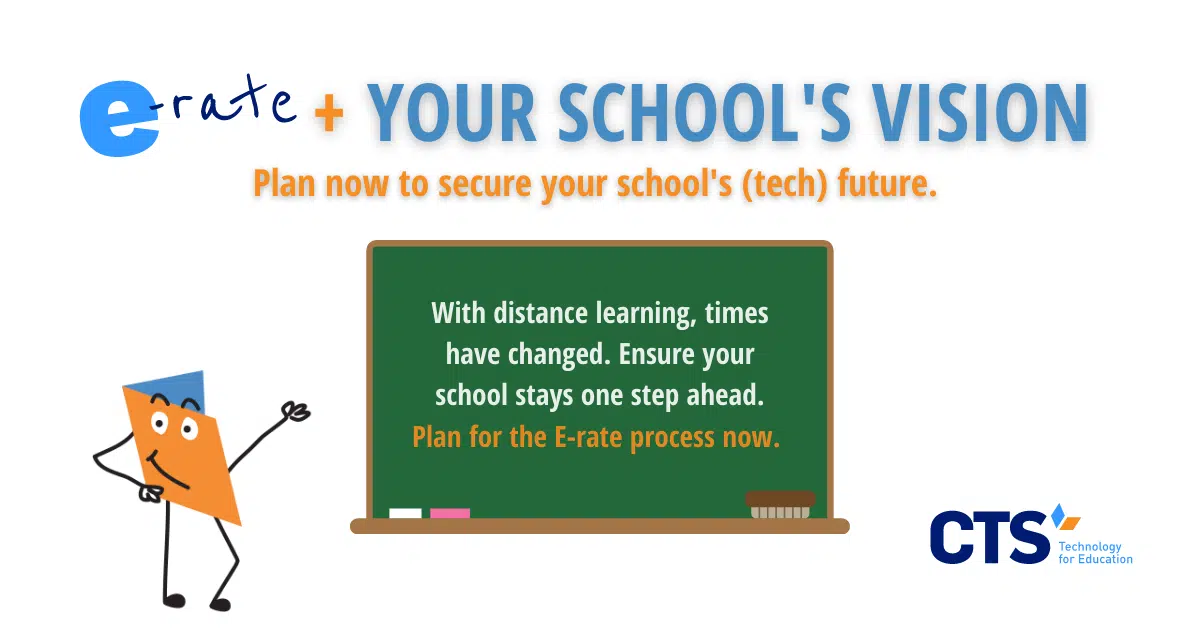E-rate funds can help offset the additional technology services costs associated with distance learning.
Distance learning has the potential to strain schools’ technology services budgets like never before. In addition to falling tax revenues, which may lead to state and local funding shortages, schools have purchased additional laptops, wireless hotspots, web conferencing accessories, and online learning management systems to accommodate the needs of a remote student body. Concepts that were once taught through in-person labs and demonstrations have been adapted for remote learning, a shift that requires investments in new instructional platforms that can be accessed from students’ homes.
Fortunately, E-rate funds may be able to help offset at least some of the costs associated with distance learning, but only if schools begin thinking strategically now, rather than later, about how best to allocate their funds. Unlike previous years, where a school may have thrown a hodgepodge of “asks” at the wall to see what sticks, this year demands a more thoughtful bidding strategy, one that accounts for the current educational and policy climate.
When choosing your technology services provider, evaluate its overall capacity to deliver for your school.
Once a school has crafted an E-rate bid tailored to its technology needs, the next step is to select a provider who can best fulfill those needs. Schools working with an E-rate consultant can lean on this individual or firm for guidance, but ultimately it’s the school’s decision. Given the fiscal and operational challenges of remote learning, choosing an experienced, high-capacity service provider is more crucial than ever.
When reviewing bids from a range of providers, schools should seek to determine which of the applicants has the highest overall capacity: does the provider offer remote and on-site troubleshooting upon request? What’s the provider’s track record at peer institutions? Does the provider have a track record of success serving schools with similar enrollments or instructional models? If not, the provider may not be the best fit.
In times of uncertainty, schools will also want to select a provider with a comprehensive understanding of the educational technology landscape. A provider’s knowledge about the current trends in the sector, as well as an ability to anticipate future developments, allows schools to more easily navigate the current landscape and prepare for future costs.
If you’re planning an expansion, consider what infrastructure your school will need.
For schools planning to increase their enrollments, add one or more grade levels, or launch an additional site, E-rate bidding considerations take on even greater importance. Selecting the wrong E-rate service provider can leave a school with subpar technology services, comprising teaching and learning at a critical time in a school’s growth.
Expansions can also put increased strain on technology budgets. Additional cabling, wireless access points, new projectors, student and staff devices all come at significant costs to the school. An E-rate service provider that can either offer these items directly or source them at a reasonable cost can dramatically reduce the financial impact of an expansion, allowing the school to devote operating funds to other instructional priorities.
When creating your bid, consider how each piece integrates with your broader technology services vision.
Schools can also use the E-rate bid-creation process to better refine and integrate their long-term technology services vision. Rather than an unwieldy conglomerate of new and outdated hardware, various operating systems, and barely used instructional platforms, schools can devote additional time to bid creation to optimize their technology services vision.
Here again, working with an experienced E-rate consulting and taking time to carefully evaluate each potential provider’s bids is critical. Just because one provider’s bid is lower than another’s, for example, doesn’t necessarily mean it adequately responds to all of the requested items. Taking the time to carefully evaluate each submission and, again, selecting one that optimizes both cost and adherence to a school’s broader technology services vision can ultimately enhance instruction and a school’s long-term technology services priorities.
New E-rate rules mean you can better predict funding levels for a five-year period.
Finally, beginning in FY 2021, each school’s E-rate funding allocation will be set for a five-year period and no longer adjusted annually for inflation. While this may ultimately decrease the amount of funds schools have available for technology services, it will allow administrators to predict with greater certainty how much funding they’ll have year-over-year.
Again, leaders can use this opportunity to take a step back, evaluate their long-term technology services goals, and project relatively stable funding levels over five years. Now is the time to create a roadmap for your school’s broader technology vision, one that further aligns student and staff technology usage with the school’s instructional model.
At CTS, we help clients make the most of their E-rate funds.
We’ve worked with more than 60 schools across the United States to make the most of their E-rate funds. Our bids do more than meet the technology needs of our partners: they generate long-term relationships that help school leaders successfully execute their technology services visions. Contact us today to learn more about our E-rate provider services and how we can best support your school.




